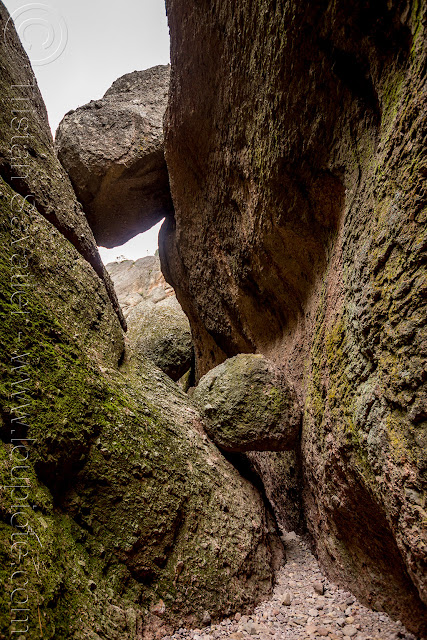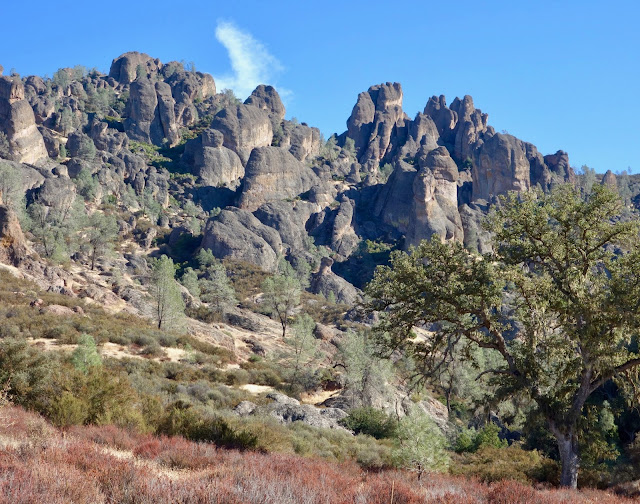On our way home from Berkeley we stopped at West Pinnacles. The park is unusual because there's no road through it's center, and one must drive for two hours to visit the east side. The day began cool, but the sun was warm against the towering pinnacles and rock faces.
23 million years ago multiple volcanoes erupted, flowed, and slid to form what would become Pinnacles National Park. What remains is a landscape unlike any other. Travelers journey through grasslands, chaparral, oak woodlands, and canyon bottoms. Hikers enter rare talus caves and emerge to towering rock spires teeming with life: Prairie and Peregrine falcons, Golden eagles, and the inspiring California condor. -from the National Park website
 |
| the trail will lead you right between and around these upthrust eroded masses |
While condors and magnificent rock spires are certainly what draws many visitors to Pinnacles, they are by no all there is to see at the park. Visitors can explore two systems of talus caves, which are formed by massive boulders wedged in ravines and widened by water and erosion.
 |
| these cascading frozen stones, stacked on each other, inspired the name balconies. |
The lava
This rock sample shows how the slowly flowing lava formed many internal layers as it began to cool. The layers eventually stretched into very thin bands.
After the rigor of hiking at 8-10,000 feet in the Sierras, hiking West Pinnacles seemed like a gentle ramble. My poles really help, too.
Rocks the size of houses will hang steadily over your head as you make your way through a cool, dark environment that provides a home for Townsend big-eared bats and red-legged frogs, among others.
 |
| entrance to Balcony Cave (from web with permission for educational use) |
I did plan on passing through the cave, but the crawl space was only about 3 feet high and worse, I had no knee pads, and my thin hiking pants would give little protection for this scramble.
 |
| crawl and squeeze through the opening between the rocks! - photo from web with permission for educational use |
If you prefer to stay in the sun, you can hike our 32 miles of trails which are decorated during the spring months with California poppies, bush lupine, mariposa lilies and a variety of other wildflowers. These flowers are pollinated by the park's 400 species of bees, a higher density of species per area than any other known place in the world!
You may also see bobcats, coyotes, black-tailed deer, any number of lizards and snakes, tarantulas, and perhaps even a mountain lion!
Another type of rock is greenish in color. Lava droplet hurled into the air formed pumice, and papilla (small volcanic rocks), which embedded in the the volcanic ash. And indeed, many of the formations did seem rather green, but also because of the mosses and lichens growing tenaciously upon their massive flanks.
While returning along the trail, I heard/saw a raptor, probably a Cooper's Hawk, make a kill and fly off with the prey in its paws.
The bird landed on the trail about 15 feet from me, permitting me a marvelous view.
The sound of the kill I'll never forget - the wings and thrashing, the gurgled gasp and cry of the prey, caught unawares.
 |
| a photo by Ron Dudley from the web - a Cooper's Hawk with prey, very much like what I saw that day |
 I also saw several oak titmice, charming little grayish crested birds flitting about among the twisting oaks.
I also saw several oak titmice, charming little grayish crested birds flitting about among the twisting oaks.
As the sun set, we drove south to King City and our comfortable rest in a Quality Inn. Dinner was at at Cork and Plough, a wine gastro-pub bistro with an industrial feel - a welcome choice. Home the next day via Santa Paula, through more of California's hilly chaparral oak woodlands and crops - delectable winter lettuces were sprouting.
We'll go back again in the spring to see the flowers.





No comments:
Post a Comment